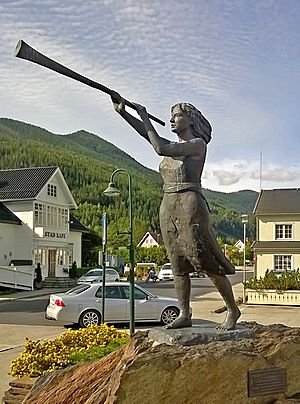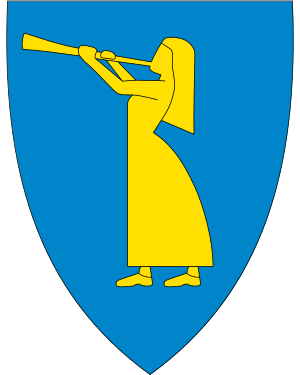Prillar-Guri facts for kids
Prillar-Guri (also spelled Prillarguri) is a famous figure from Norwegian history. People say she was a brave woman from Sel, Norway. She played a very important part in the Battle of Kringen in August 1612. Her story has been passed down through generations.
The Battle of Kringen
The Battle of Kringen happened during the Kalmar War. This was a conflict between Sweden and Denmark-Norway. Before the battle, Swedish soldiers had caused a lot of damage in Norway. They had also attacked Norwegian soldiers.
Because of this, about 500 Norwegian farmers decided to fight back. They planned to ambush a group of Scottish soldiers. These Scottish soldiers were marching through Norway. The Norwegians chose a perfect spot for their ambush. It was a narrow part of the valley called Kringen.
The battle was very intense. The Norwegian farmers won a great victory. Many Scottish soldiers were captured or killed. This victory is still celebrated today in places like Otta and Dovre.
Who Was Pillarguri?
Pillarguri's real name was Guri. The name Guri is a common Norwegian woman's name. It comes from an old Norse word meaning "good."
The word "Prillar" comes from the horn Guri used. There is an old Norwegian instrument called a prillarhorn. It was made from a cow's horn and could be played like a trumpet. "Prille" is also a Norwegian word. It means to play music, especially on a hardanger fiddle.
According to old stories, Pillarguri stood on a high point. This spot was across the river from the Scottish troops. Today, this height is called Pillarguritoppen. She either played her horn to get their attention. Then she moved a piece of clothing to signal the ambush. Or, she started playing her horn as the signal for the attack.
It's interesting that official reports from the Battle of Kringen do not mention Pillarguri. Her story mostly comes from oral tradition. This means it was told by people for many years. She also appears in poems written much later. However, women were rarely mentioned in official documents back then.
In modern pictures, Pillarguri is often shown as a young lady. She has long, light-colored hair. She is usually playing a lur. A lur is a long horn used in Scandinavia a long time ago. But there are no old descriptions to say she looked like this. This image is more of a romantic idea.
Pillarguri's Legacy
Pillarguri's story has become very popular. It is told in many poems and songs. There is even a traditional song about her. Her story first appeared in writing in 1838. This was in a book by Hans Peter Schnitler Krag.
Later, a famous Norwegian author named Rudolf Muus wrote a novel. This made Pillarguri even more well-known. Her story also appeared in poems by Edvard Storm, Henrik Wergeland, and Gerhard Schöning.
Her name is also remembered in many Hardanger fiddle dance tunes. These tunes seem to be quite old. This suggests her story was known long before it was written down.
Today, you can see a statue of Pillarguri in Otta, Norway. There is also a special award called the Pillarguri prize. It is given out during the yearly Pillarguri Festival in Otta. In 1912, a memorial was built for the 300-year anniversary of the battle. Pillarguri is shown on this memorial. She is also on the official coat of arms for the municipality of Sel in Norway.



